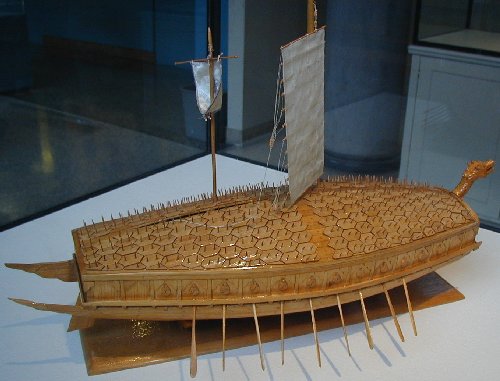The Ironclad Turtle
Today, we meet a turtle with an iron shell. The University of Houston's College of Engineering presents this series about the machines that make our civilization run, and the people whose ingenuity created them.
When the Japanese ruler Hideyoshi invaded Korea in 1592, he was armed with a new weapon. He carried muskets that'd been sold to him by the Portuguese. Hideyoshi quickly overran Seoul, and he seemed to be on his way to conquering the country.
Then the Korean government turned to Admiral Sun-Shin Yi. Yi was a brilliant strategist who'd seen war coming. He'd raised private money to construct a small fleet of utterly remarkable ships. They were called Turtle Boats.
The Turtle Boat was ironclad. And it really did look like a seventy-foot-long turtle. It had a low, rounded roof, bristling with spikes to prevent boarding. In battle, its sails came down and twenty oars powered it. Just above the oars were ports for cannon, small firearms, and arrows. It had features in common with both Civil War ironclads, the Monitor and the Merrimac, built two hundred and fifty years later. A Turtle Boat was equipped with a ram as well as a dragon's head on the prow. The dragon's head poured out smoke to frighten the enemy and to lay down a smoke screen.
So, for several months, Yi used his new weapon to tear into the Japanese fleet of some two hundred ships. He devastated it. The war ended in a truce, with Korea divided politically. Admiral Yi had stopped the invasion, but he'd stirred up political jealousy by doing it. His opponents had him thrown in jail, and there he sat until Hideyoshi renewed the invasion in 1597.
With Yi out of the way, the Japanese ravaged the Korean navy. Yi was finally exonerated and put back in charge of just twelve surviving warships. Less than a month later he ambushed 133 Japanese ships with his tiny fleet. He sank thirty-one of them and drove the rest off. He bought time to rebuild his navy.
A year later, the Japanese were fighting a losing war. They began a total withdrawal in an armada of five hundred ships. Then Admiral Yi struck once again with his Turtle -- with his mad, visionary weapon. He sank hundreds of ships -- over half the fleet.
The carnage far exceeded the slaughter in Drake's defeat of the Spanish Armada, which had taken place around the world just ten years before. In fact, the Japanese loss of fifty thousand sailors was twice the combined number who'd merely sailed in the English and Spanish fleets. The Japanese were so badly beaten that they stayed away from Korea until 1904. Admiral Yi was killed in the battle. And, in a strange way, so too was the Turtle.
The oddest thing about this already-odd chapter of naval history is that the Turtle Boat didn't outlive the war. Neither it, nor this vast naval encounter, are even footnotes in Western history books. During the American Revolution, David Bushnell called his experimental one-man submarine The Turtle. But we didn't again see anything resembling the Korean Turtle boat until the Civil War -- so recent as to have been within both my own grandfathers' lifetimes.
I'm John Lienhard, at the University of Houston, where we're interested in the way inventive minds work.
(Theme music)
Jho, S-d., Yi Sung-shin: A National Hero of Korea. Chin Hae: Choongmoo-kong Society, Naval Academy, Korea, 1970.
Admiral Yi Sun-sin: A Brief Overview of his Life and Achievements. (no author given) (New York: Diamond Sutra Recitation Group, no date given.
This episode is a revised version of Episode 117.

Model of a Turtle Boat in the MIT Naval Museum